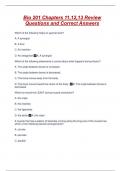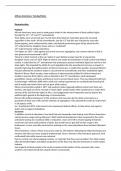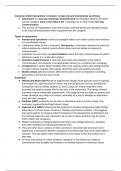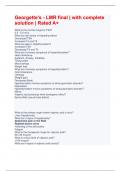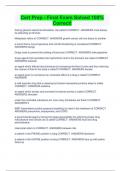Management
control
samenvatting
Lecture
1
Management
control
=
the
process
by
which
management
ensures
that
people
in
the
organization
carry
out
its
objectives
and
strategies.
This
is
done
by
encouraging
(so
encourage
people
to
do
the
right
thing,
for
example
by
using
incentive
systems),
enables
(not
only
about
the
motivation
but
also
about
the
ability,
for
example
putting
people
in
the
right
job,
which
competences
fits
the
job
the
best?)
or
forces
(for
example
action
controls)
employees
to
act
in
the
organizations
best
interest.
Includes
all
devices/mechanisms
used
to
ensure
that
employee
behavior
is
consistent
with
the
objectives
and
strategies.
So
it
is
about
gaining
a
higher
probability
that
organizations
objectives
are
achieved.
Gartenberg
et
al.
(2019)
conducted
a
survey
to
find
out
how
the
purpose
of
organizations
affects
their
financial
results
and
in
which
way.
-‐>
Firms
with
high
purpose
(clear
objectives)
and
clarity
(path
for
realizing
these
objectives)
have
systematically
higher
future
accounting
and
stock
market
performance.
When
employees
believe
in
the
purpose
of
their
organization
and
the
clarity
on
the
path
toward
that
purpose,
experience
better
performance.
When
we
connect
the
findings
of
Gartenberg
et
al.
to
the
van
der
Steden
textbook
there
are
2
important
things:
-‐ Strategic
control:
understanding
of
the
strategy
and
how
valid
is
this
strategy
that
we
maintain?
(high
purpose
and
clarity)
-‐ Management
control:
about
implementing
this
strategy
Objectives:
before
we
can
do
something
with
purpose,
we
need
to
understand
what
we
want
to
realize
in
the
end.
Can
be
very
clear,
when
management
sets
out
these
objectives,
but
can
also
be
changing
over
time:
emerging
objectives.
Express
them
in
different
ways:
-‐ Financial
(ROI,
profit,
growth
of
turnover,
sales)
versus
non-‐financial
(customer
satisfaction)
-‐ Quantified:
explicit
(percentages,
for
example
growth
of
10%)
versus
implicit
(growth,
but
not
specific
how
much)
-‐ Economic,
social
(how
do
we
treat
employees,
how
do
we
treat
environment?),
environmental
(how
do
we
manage
pollution?),
societal
(how
do
we
manage
culture?)
Balance
these
objectives!
Strategies:
how
should
resources
be
used
to
meet
the
objectives?
There
are
limited
resources,
so
focus
on
the
things
the
organization
is
best
in:
competitive
advantages.
Constrain
employees
to
focus
activities
on
what
the
organization
does
best
relative
to
competitors.
Control
has
2
layers
that
managers
have
to
think
about:
1. Strategic
control:
question
whether
our
strategy
is
still
valid?
When
you
have
an
answer
on
this
ask
whether
the
strategy
need
revision.
Intended
strategy
=
when
we
know
in
advance
that
the
strategy
will
go
into
a
direction
which
is
not
fully
in
line
with
the
objectives
of
the
organization.
Emergent
strategy
=
strategy
that
occurs
as
we
are
processing
the
activities
and
get
feedback
from
the
environment.
Example:
when
corona
broke
out,
some
companies
stopped
investing
in
new
product,
so
when
the
government
forced
a
lockdown
or
something
they
would
not
get
stuck
with
to
much
products.
That
is
intended
strategy.
The
opposite
happened
because
also
during
lockdown
organizations
were
able
to
sell
products,
so
now
the
organization
has
no
or
little
growth
opportunity.
This
is
an
emergent
strategy.
, 2. Management
control:
are
employees
likely
to
behave
appropriately
in
the
strategy?
If
all
employees
could
always
be
relied
on
to
do
what
is
best
for
the
organization,
there
would
be
no
need
for
management
control
systems
(MCS)
to
exist.
MC
is
about
encouraging
people
to
take
desirable
actions.
How
can
we
move
people
into
a
certain
direction
that
they
take
the
actions
that
we
want
them
to
take?
-‐>
Behavioral
orientation
The
planning/control
cycle:
Goals
(objective
setting,
top
management)-‐>
strategy
formulation
(strategic
control)
-‐>
strategy
implementation
(management
control)
And
then
it
also
goes
back!
Employees
can
get
feedback
from
their
customers
and
provide
this
information
back
to
the
strategic
managers.
They
are
going
to
think
about
how
they
can
revise
the
strategy
based
on
this
information
and
then
in
the
end
maybe
the
objective
setting
is
also
changing.
3
control
problems
related
to
people’s
behavior:
1. Lack
of
direction:
do
they
understand
what
the
organization
wants
and
what
is
expected
from
them?
-‐>
use
guidance
to
cover
this
problem.
With
a
performance
measurement
system
or
budgeting
system,
provide
indications
of
resources
they
employees
are
allowed
to
use
and
the
outcomes
that
the
organization
expects
to
realize.
2. Lack
of
motivation:
are
they
also
encouraged
to
do
so?
So
will
they
work
consistent
hard
and
try
to
do
what
is
expected
of
them?
-‐
goal
incongruence
(when
employee
wants
to
achieve
something
else
than
the
organization)
-‐
self-‐interested
behavior
(do
what
they
find
most
exiting
instead
of
what’s
best
for
the
firm)
-‐>
to
cover
this
problem,
make
rules,
force
people
to
do
something.
Or
to
the
bottom:
how
can
we
align
the
congruence
of
the
goal
of
the
individual
and
the
organization?
Like
an
incentive
system,
bonus
system,
etc.
3. Personal
limitations:
if
we
overcome
directional
and
motivational
problems,
are
employees
capable
of
doing
what
is
expected
from
them?
Problem
is
the
competence.
-‐>
to
cover
use
replacement
with
tasks
with
the
right
activities,
training
and
building
experience
Therefore
good
control
has
a
high
probability
that
the
objectives
will
be
achieved
and
a
low
probability
that
major
unpleasant
surprises
will
occur.
Tradeoff
has
to
be
made:
how
much
are
we
going
to
invest
in
controls
that
help
us
to
achieve
this?
Focus
on:
-‐ Future
orientated
controls
-‐ Objectives-‐driven
controls
(aligned
with
the
objectives,
so
if
they
change,
also
change
controls)
-‐ Controls
are
economically
desirable
(how
much
to
invest
relative
to
the
costs)
Control
can
be
achieved
through:
1. Control
problem
avoidance
-‐
Activity
elimination
(subcontracting,
offshoring,
divesting)
because
we
don’t
have
the
knowledge,
or
it
is
less
costly
to
outsource
-‐
Automation
(eliminates
human
problems,
but
only
for
more
easy
decision
situations.
For
complex
decisions
still
people
needed.
Can
be
costly
also)
-‐
Centralization
decision
making
(don’t
allow
people
to
make
decisions,
only
the
higher
level
management.
So
these
managers
still
have
to
align
objectives,
so
problem
is
only
taken
away
partly)
2. Management
control
systems
Different
kinds
of
controls
that
relate
to
(are
often
used
in
combination):
-‐
Action
controls
(actions
taken,
specify
actions
that
are
desired)
-‐
Result
controls
(results
produced,
set
targets,
focus
on
outcomes
and
not
how
they
achieved
the
outcomes)
(ch.
2)
-‐
People
controls
(hiring,
training,
culture
environment,
shared
values
&
norms)
, When
do
we
use
these
kinds
of
controls?
Large
project:
you
are
not
able
to
measure
the
outcome
results
specifically
because
of
for
example
the
weather,
maybe
because
of
a
storm
you
can
not
meet
the
target
of
delivery
date.
There
are
a
lot
of
uncertainties,
which
makes
the
ability
to
measure
results
lower.
So
therefore
you
take
action
controls
because
managers
are
not
fully
responsible
for
the
outcomes.
Research
lab:
a
lot
of
uncertainty,
you
don’t
know
the
outcomes
or
best
actions
to
take.
So
you
have
to
rely
on
the
intrinsic
motivation
of
people
and
the
cultural
environment
in
the
organization.
Result
controls
Result
controls:
it
is
about
measuring
outcomes,
and
based
on
that
measure
you
get
rewarding
or
punishment.
(results
accountability
=
only
accountable
for
what
you
can
really
influence).
Influences
actions
since
employees
become
concerned
about
their
effects,
because
these
effects
become
clear
when
measuring
result
controls.
Elements
of
result
controls:
-‐ Defining
performance
dimensions:
what
do
we
see
as
the
desired
performance
and
what
are
the
measurements
that
we
keep
the
employees
accountable
for?
If
you
keep
someone
accountable
for
a
performance
measurement,
he
will
focus
on
that
measurement
and
not
on
other
measurements
that
he
is
not
accountable
for:
what
you
measure
is
what
you
get.
So
if
not
congruent
with
objectives,
controls
will
encourage
employees
to
do
the
wrong
things.
-‐ Measuring
performance
(often
used
both)
-‐
Objective:
financial
(market-‐based
(stock
price),
accounting-‐based
(return
on
assets))
or
non-‐
financial
(market
share,
waste,
cycle
time)
-‐
Subjective:
managerial
characteristics
(being
a
team
player)
-‐ Setting
performance
targets
-‐
Motivational
effects
(use
benchmarks,
for
example
other
managers
within
the
firm
or
in
other
firms)
+
allow
them
to
interpret
own
performance
(how
have
I
done?
How
can
I
do
it
better
next
time?)
control
samenvatting
Lecture
1
Management
control
=
the
process
by
which
management
ensures
that
people
in
the
organization
carry
out
its
objectives
and
strategies.
This
is
done
by
encouraging
(so
encourage
people
to
do
the
right
thing,
for
example
by
using
incentive
systems),
enables
(not
only
about
the
motivation
but
also
about
the
ability,
for
example
putting
people
in
the
right
job,
which
competences
fits
the
job
the
best?)
or
forces
(for
example
action
controls)
employees
to
act
in
the
organizations
best
interest.
Includes
all
devices/mechanisms
used
to
ensure
that
employee
behavior
is
consistent
with
the
objectives
and
strategies.
So
it
is
about
gaining
a
higher
probability
that
organizations
objectives
are
achieved.
Gartenberg
et
al.
(2019)
conducted
a
survey
to
find
out
how
the
purpose
of
organizations
affects
their
financial
results
and
in
which
way.
-‐>
Firms
with
high
purpose
(clear
objectives)
and
clarity
(path
for
realizing
these
objectives)
have
systematically
higher
future
accounting
and
stock
market
performance.
When
employees
believe
in
the
purpose
of
their
organization
and
the
clarity
on
the
path
toward
that
purpose,
experience
better
performance.
When
we
connect
the
findings
of
Gartenberg
et
al.
to
the
van
der
Steden
textbook
there
are
2
important
things:
-‐ Strategic
control:
understanding
of
the
strategy
and
how
valid
is
this
strategy
that
we
maintain?
(high
purpose
and
clarity)
-‐ Management
control:
about
implementing
this
strategy
Objectives:
before
we
can
do
something
with
purpose,
we
need
to
understand
what
we
want
to
realize
in
the
end.
Can
be
very
clear,
when
management
sets
out
these
objectives,
but
can
also
be
changing
over
time:
emerging
objectives.
Express
them
in
different
ways:
-‐ Financial
(ROI,
profit,
growth
of
turnover,
sales)
versus
non-‐financial
(customer
satisfaction)
-‐ Quantified:
explicit
(percentages,
for
example
growth
of
10%)
versus
implicit
(growth,
but
not
specific
how
much)
-‐ Economic,
social
(how
do
we
treat
employees,
how
do
we
treat
environment?),
environmental
(how
do
we
manage
pollution?),
societal
(how
do
we
manage
culture?)
Balance
these
objectives!
Strategies:
how
should
resources
be
used
to
meet
the
objectives?
There
are
limited
resources,
so
focus
on
the
things
the
organization
is
best
in:
competitive
advantages.
Constrain
employees
to
focus
activities
on
what
the
organization
does
best
relative
to
competitors.
Control
has
2
layers
that
managers
have
to
think
about:
1. Strategic
control:
question
whether
our
strategy
is
still
valid?
When
you
have
an
answer
on
this
ask
whether
the
strategy
need
revision.
Intended
strategy
=
when
we
know
in
advance
that
the
strategy
will
go
into
a
direction
which
is
not
fully
in
line
with
the
objectives
of
the
organization.
Emergent
strategy
=
strategy
that
occurs
as
we
are
processing
the
activities
and
get
feedback
from
the
environment.
Example:
when
corona
broke
out,
some
companies
stopped
investing
in
new
product,
so
when
the
government
forced
a
lockdown
or
something
they
would
not
get
stuck
with
to
much
products.
That
is
intended
strategy.
The
opposite
happened
because
also
during
lockdown
organizations
were
able
to
sell
products,
so
now
the
organization
has
no
or
little
growth
opportunity.
This
is
an
emergent
strategy.
, 2. Management
control:
are
employees
likely
to
behave
appropriately
in
the
strategy?
If
all
employees
could
always
be
relied
on
to
do
what
is
best
for
the
organization,
there
would
be
no
need
for
management
control
systems
(MCS)
to
exist.
MC
is
about
encouraging
people
to
take
desirable
actions.
How
can
we
move
people
into
a
certain
direction
that
they
take
the
actions
that
we
want
them
to
take?
-‐>
Behavioral
orientation
The
planning/control
cycle:
Goals
(objective
setting,
top
management)-‐>
strategy
formulation
(strategic
control)
-‐>
strategy
implementation
(management
control)
And
then
it
also
goes
back!
Employees
can
get
feedback
from
their
customers
and
provide
this
information
back
to
the
strategic
managers.
They
are
going
to
think
about
how
they
can
revise
the
strategy
based
on
this
information
and
then
in
the
end
maybe
the
objective
setting
is
also
changing.
3
control
problems
related
to
people’s
behavior:
1. Lack
of
direction:
do
they
understand
what
the
organization
wants
and
what
is
expected
from
them?
-‐>
use
guidance
to
cover
this
problem.
With
a
performance
measurement
system
or
budgeting
system,
provide
indications
of
resources
they
employees
are
allowed
to
use
and
the
outcomes
that
the
organization
expects
to
realize.
2. Lack
of
motivation:
are
they
also
encouraged
to
do
so?
So
will
they
work
consistent
hard
and
try
to
do
what
is
expected
of
them?
-‐
goal
incongruence
(when
employee
wants
to
achieve
something
else
than
the
organization)
-‐
self-‐interested
behavior
(do
what
they
find
most
exiting
instead
of
what’s
best
for
the
firm)
-‐>
to
cover
this
problem,
make
rules,
force
people
to
do
something.
Or
to
the
bottom:
how
can
we
align
the
congruence
of
the
goal
of
the
individual
and
the
organization?
Like
an
incentive
system,
bonus
system,
etc.
3. Personal
limitations:
if
we
overcome
directional
and
motivational
problems,
are
employees
capable
of
doing
what
is
expected
from
them?
Problem
is
the
competence.
-‐>
to
cover
use
replacement
with
tasks
with
the
right
activities,
training
and
building
experience
Therefore
good
control
has
a
high
probability
that
the
objectives
will
be
achieved
and
a
low
probability
that
major
unpleasant
surprises
will
occur.
Tradeoff
has
to
be
made:
how
much
are
we
going
to
invest
in
controls
that
help
us
to
achieve
this?
Focus
on:
-‐ Future
orientated
controls
-‐ Objectives-‐driven
controls
(aligned
with
the
objectives,
so
if
they
change,
also
change
controls)
-‐ Controls
are
economically
desirable
(how
much
to
invest
relative
to
the
costs)
Control
can
be
achieved
through:
1. Control
problem
avoidance
-‐
Activity
elimination
(subcontracting,
offshoring,
divesting)
because
we
don’t
have
the
knowledge,
or
it
is
less
costly
to
outsource
-‐
Automation
(eliminates
human
problems,
but
only
for
more
easy
decision
situations.
For
complex
decisions
still
people
needed.
Can
be
costly
also)
-‐
Centralization
decision
making
(don’t
allow
people
to
make
decisions,
only
the
higher
level
management.
So
these
managers
still
have
to
align
objectives,
so
problem
is
only
taken
away
partly)
2. Management
control
systems
Different
kinds
of
controls
that
relate
to
(are
often
used
in
combination):
-‐
Action
controls
(actions
taken,
specify
actions
that
are
desired)
-‐
Result
controls
(results
produced,
set
targets,
focus
on
outcomes
and
not
how
they
achieved
the
outcomes)
(ch.
2)
-‐
People
controls
(hiring,
training,
culture
environment,
shared
values
&
norms)
, When
do
we
use
these
kinds
of
controls?
Large
project:
you
are
not
able
to
measure
the
outcome
results
specifically
because
of
for
example
the
weather,
maybe
because
of
a
storm
you
can
not
meet
the
target
of
delivery
date.
There
are
a
lot
of
uncertainties,
which
makes
the
ability
to
measure
results
lower.
So
therefore
you
take
action
controls
because
managers
are
not
fully
responsible
for
the
outcomes.
Research
lab:
a
lot
of
uncertainty,
you
don’t
know
the
outcomes
or
best
actions
to
take.
So
you
have
to
rely
on
the
intrinsic
motivation
of
people
and
the
cultural
environment
in
the
organization.
Result
controls
Result
controls:
it
is
about
measuring
outcomes,
and
based
on
that
measure
you
get
rewarding
or
punishment.
(results
accountability
=
only
accountable
for
what
you
can
really
influence).
Influences
actions
since
employees
become
concerned
about
their
effects,
because
these
effects
become
clear
when
measuring
result
controls.
Elements
of
result
controls:
-‐ Defining
performance
dimensions:
what
do
we
see
as
the
desired
performance
and
what
are
the
measurements
that
we
keep
the
employees
accountable
for?
If
you
keep
someone
accountable
for
a
performance
measurement,
he
will
focus
on
that
measurement
and
not
on
other
measurements
that
he
is
not
accountable
for:
what
you
measure
is
what
you
get.
So
if
not
congruent
with
objectives,
controls
will
encourage
employees
to
do
the
wrong
things.
-‐ Measuring
performance
(often
used
both)
-‐
Objective:
financial
(market-‐based
(stock
price),
accounting-‐based
(return
on
assets))
or
non-‐
financial
(market
share,
waste,
cycle
time)
-‐
Subjective:
managerial
characteristics
(being
a
team
player)
-‐ Setting
performance
targets
-‐
Motivational
effects
(use
benchmarks,
for
example
other
managers
within
the
firm
or
in
other
firms)
+
allow
them
to
interpret
own
performance
(how
have
I
done?
How
can
I
do
it
better
next
time?)


